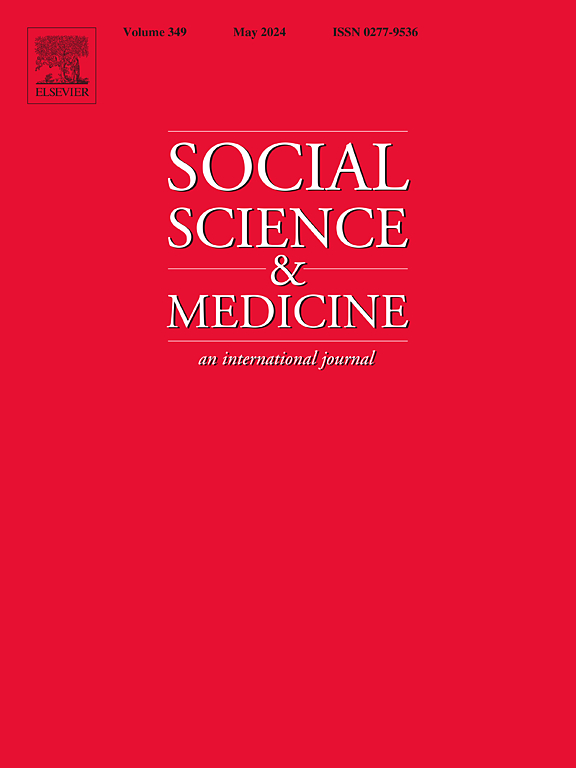Looking to the past: Investigating 10-year place histories as a determinant of home food environments in the Healthy Communities Study
IF 5
2区 医学
Q1 PUBLIC, ENVIRONMENTAL & OCCUPATIONAL HEALTH
引用次数: 0
Abstract
Emerging research suggests there is a need to consider the importance of place histories in studying neighborhood effects. Guided by a life course of place framework, the objective of this study is to investigate the relationship between two place history exposures and three contemporary home food environment outcomes. Exposures included 10-year neighborhood socioeconomic status (SES) histories and multi-year nutrition community programming and policy (CPP) histories. Outcomes included the availability of healthy foods in the home, the availability of unhealthy foods in the home, and household food insecurity. Associations are investigated using cross-sectional and retrospective data on 4210 US families in the national, observational Healthy Communities Study (2013–2015). Multilevel regression models, adjusted for household income and other factors, were fit for each exposure and outcome. Households residing in neighborhoods with intermittently low, consistently moderate, intermittently high, and consistently high SES histories had greater availability of healthy foods in the home than households in neighborhoods with consistently low SES histories (adjusted βs: 0.11 [95% CI: 0.02, 0.20], 0.13 [95% CI: 0.06, 0.21], 0.23 [95% CI: 0.13, 0.34], and 0.24 [95% CI: 0.15, 0.33], respectively). Households in consistently high SES neighborhoods also had a lower likelihood of household food insecurity than those in consistently low SES neighborhoods (adjusted OR: 0.54 [95% CI: 0.42, 0.71]). Neighborhood SES histories were not significantly associated with the availability of unhealthy foods in the home. Nutrition CPP histories were not significantly associated with food insecurity or the availability of unhealthy foods in the home. However, more intense nutrition CPP histories were significantly associated with greater availability of healthy foods in the home. Moreover, effect estimates increased with more long-term historical accounts of CPPs (adjusted βs: 1-year CPP histories, 0.21 [95% CI: 0.03, 0.39]; 3-year CPP histories, 0.22 [95% CI: 0.03, 0.41]; 6-year CPP histories, 0.25 [95% CI: 0.04, 0.46]; 10-year CPP histories, 0.28 [95% CI: 0.05, 0.50]). To curb food insecurity and promote the availability of healthy foods, the findings suggest considering how neighborhoods develop and evolve over time with respect to SES and nutrition CPP implementation.
回顾过去:调查健康社区研究中作为家庭饮食环境决定因素的 10 年地方历史。
新近的研究表明,在研究邻里效应时有必要考虑地方历史的重要性。在地方生命历程框架的指导下,本研究旨在调查两种地方历史暴露与三种当代家庭食品环境结果之间的关系。暴露因素包括 10 年的邻里社会经济地位(SES)历史和多年的营养社区计划和政策(CPP)历史。结果包括家庭中健康食品的可获得性、家庭中不健康食品的可获得性以及家庭食品不安全性。研究使用了全国性观察性健康社区研究(2013-2015 年)中 4210 个美国家庭的横截面和回顾性数据,对相关性进行了调查。在对家庭收入和其他因素进行调整后,针对每种暴露和结果拟合了多层次回归模型。居住在间歇性低、持续性中、间歇性高和持续性高社会经济地位社区的家庭比居住在持续性低社会经济地位社区的家庭更容易获得健康食品(调整后的βs:分别为 0.11 [95% CI: 0.02, 0.20]、0.13 [95% CI: 0.06, 0.21]、0.23 [95% CI: 0.13, 0.34] 和 0.24 [95% CI: 0.15, 0.33])。持续高社会经济地位社区的家庭出现家庭粮食不安全的可能性也低于持续低社会经济地位社区的家庭(调整后 OR:0.54 [95% CI:0.42,0.71])。邻里社会经济地位历史与家庭中不健康食品的可获得性无明显关联。营养 CPP 历史与粮食不安全或家中是否有不健康食品没有明显关系。然而,营养 CPP 历史越长,家中健康食品的可获得性就越高。此外,效果估计值随着 CPP 历史记录的增加而增加(调整后的βs:1 年的 CPP 历史记录为 0.21 [95% CI:0.03,0.39];3 年的 CPP 历史记录为 0.22 [95% CI:0.03,0.41];6 年的 CPP 历史记录为 0.25 [95% CI:0.04,0.46];10 年的 CPP 历史记录为 0.28 [95% CI:0.05,0.50])。为了遏制食品不安全问题并促进健康食品的供应,研究结果表明,在实施社会经济地位和营养综合方案的过程中,应考虑社区如何随着时间的推移而发展和演变。
本文章由计算机程序翻译,如有差异,请以英文原文为准。
求助全文
约1分钟内获得全文
求助全文
来源期刊

Social Science & Medicine
PUBLIC, ENVIRONMENTAL & OCCUPATIONAL HEALTH-
CiteScore
9.10
自引率
5.60%
发文量
762
审稿时长
38 days
期刊介绍:
Social Science & Medicine provides an international and interdisciplinary forum for the dissemination of social science research on health. We publish original research articles (both empirical and theoretical), reviews, position papers and commentaries on health issues, to inform current research, policy and practice in all areas of common interest to social scientists, health practitioners, and policy makers. The journal publishes material relevant to any aspect of health from a wide range of social science disciplines (anthropology, economics, epidemiology, geography, policy, psychology, and sociology), and material relevant to the social sciences from any of the professions concerned with physical and mental health, health care, clinical practice, and health policy and organization. We encourage material which is of general interest to an international readership.
 求助内容:
求助内容: 应助结果提醒方式:
应助结果提醒方式:


